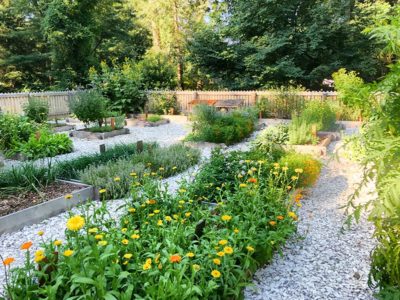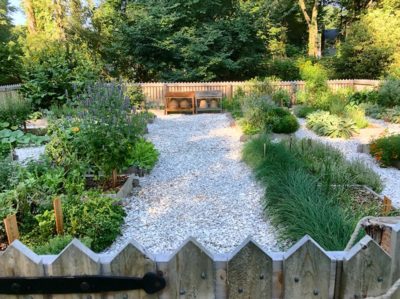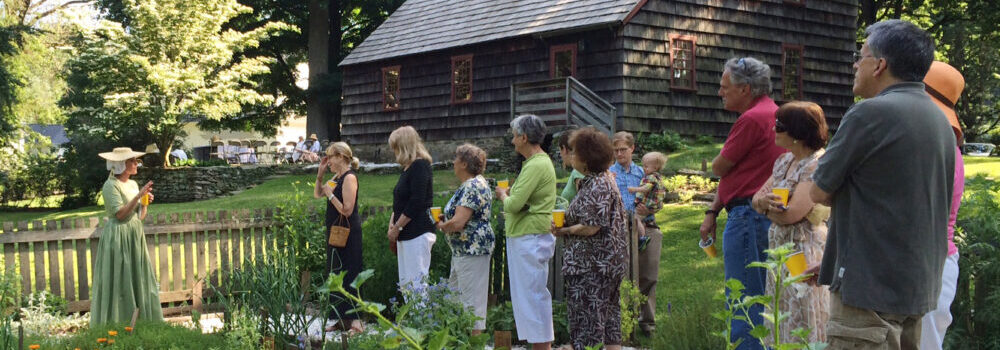Jane and David Ogden
 In 1750, when Jane and David Ogden settled into their Bronson Road home as newlyweds, their property included approximately 75 acres of land. Some were close to their house and was farmed and used for grazing. Other property was farther away. Acres within the salt marsh provided grass for animal fodder. Acres not under tillage likely included a wood lot to provide fuel for heat and lumber as needed. The balance lay fallow for future use.
In 1750, when Jane and David Ogden settled into their Bronson Road home as newlyweds, their property included approximately 75 acres of land. Some were close to their house and was farmed and used for grazing. Other property was farther away. Acres within the salt marsh provided grass for animal fodder. Acres not under tillage likely included a wood lot to provide fuel for heat and lumber as needed. The balance lay fallow for future use.
The crops raised on the Ogden farm provided for their household needs, with excess sold for a modest profit. Jane Ogden would have traded surplus from her garden in the informal domestic economy typical of this era — and which persists in our own. A neighbor might reciprocate the gift of a few pumpkins by offering a garlic chain, or return the favor of attendance at a sick bed with a basket of carrots and tender herbs. Some women kept account books of such exchanges, though no such records survive from the Ogden household.
While David Ogden and his sons tended the farm, Jane Ogden and her daughters cared for the garden that provided for their family in a range of ways. Jane’s garden supplied vegetables for the table, herbs for seasoning, hops for beer, and herbs for healing. Then as now, flowers offered scent and beauty. Some plants, such as the peas and carrots Jane might have put in her stew pot, were of European origin. Some had been introduced to Europe from Asia before the colonial era. Roses, for example, were first cultivated in China, spread to the middle east, and then traveled along the conquest routes of the Roman empire. Other plants, such as corn, beans, and squash, were native species that colonists had learned to value through contact with indigenous people.
Jane’s garden has been carefully researched, reproduced, and maintained through the efforts of the Fairfield Garden Club, an affiliate of the Garden Club of America. The scale of the plantings is appropriate to the size of the Ogden family and the features of the garden are typical of the period. Raised beds allowed for better drainage and also extended the garden’s growing season as the earth within thawed more quickly than the ground. The garden’s crushed shell paths reduced weed growth and therefore reduced maintenance.
Perhaps noticed though not fully understood, the shell path had the additional benefit of contributing calcium to the soil. Fencing reduced the likelihood of roaming animals reaping the profits of Jane’s hard work. And the range of plant material grown in Jane’s Garden reflects the selections typical of her era.
Animals in the Garden
While fencing was certainly a help to Jane as she struggled to protect her garden, animals were a real threat. Then as now, deer were a potential problem — though, without significant encroachment on their habitat, these were a minimal threat. Much more problematic was Jane’s neighbor’s livestock… or even her own. A horse or cow that had escaped its pasture could trample as well as sample the bounty of Jane’s garden. A bigger danger: in early America, pigs weren’t necessarily penned. Instead, colonists branded piglets after weaning in spring and released them to feed in the wild. In the fall, a farmer would reclaim the pigs he could locate and process their meat for the family to enjoy through the winter. But feral pigs would have found Jane’s garden at least as tasty as what they might forage in the woods.
Early Fairfield, like many colonial towns, had an animal warden who could be summoned to remove a wandering animal visitor who had encroached on a neighbor’s garden. The owners would need to pay a fine to reclaim their animal from the local pound.
But not all wandering animals were unwelcome. Jane would have been as happy to host her neighbor’s honey bees as to provide food for her own. While America has approximately four thousand native bee species which serve as excellent pollinators of native plants, honey bees were imported by early colonists both for their delicious honey and to aid in the pollination of European plant species.
Today, the honey bees maintained as part of Jane’s Garden may be spotted contributing now as they did in the eighteenth century, sharing their excess honey as well as their horticultural handiwork.
As typical of nearly all New England farmers, the Ogden family also owned a range of animals. They had horses for efficient transportation, a pair of oxen for plowing, and sheep for wool and meat. The Ogden’s sheep were their lawnmowers, keeping the grass low and tidy as they grazed near the house. Steer provided meat and cows provided milk and cheese for the table. The Ogdens also bred cattle, most likely selling off animals they didn’t need. We don’t know if the Ogdens kept their pigs penned or released them into the woods, but we do know that at the time of David Ogden’s death in June of 1776 he owned a sow with six young piglets.
Jane's "Improvements"
 Early colonists viewed the establishment of farms not merely as a domestic necessity but also as a fulfillment of biblical injunction. As practicing Congregationalists, Jane and her family would have noted that in Genesis, God had given Adam dominion over the animals and plants of the earth. In early America, agriculture was understood as an “improvement” on the forest and a measure of civilization. Further, colonists had an interest in improving the quality and quantity of their fields and the bounty of their gardens. But not too much interest. Early New England farmers practiced what amounted to swidden agriculture — a polite term for what we now describe as “slash and burn.” Farmers who tilled in regions with topsoil of relatively thin depth abandoned exhausted fields and moved elsewhere rather than rotating their crops or fertilizing their earth.
Early colonists viewed the establishment of farms not merely as a domestic necessity but also as a fulfillment of biblical injunction. As practicing Congregationalists, Jane and her family would have noted that in Genesis, God had given Adam dominion over the animals and plants of the earth. In early America, agriculture was understood as an “improvement” on the forest and a measure of civilization. Further, colonists had an interest in improving the quality and quantity of their fields and the bounty of their gardens. But not too much interest. Early New England farmers practiced what amounted to swidden agriculture — a polite term for what we now describe as “slash and burn.” Farmers who tilled in regions with topsoil of relatively thin depth abandoned exhausted fields and moved elsewhere rather than rotating their crops or fertilizing their earth.
Luckily, for many coastal and river valley towns of New England, the soil was sufficiently fertile to sustain multiple generations without substantive intervention. It wasn’t until after the revolutionary era that New England farmers felt a real urgency to improve their soil. Nonetheless, Jane Ogden likely used fish and manure to fertilize her garden and may have engaged in composting. And every time she pulled out a weaker plant to sustain a hardier example growing close by, dug and discarded a less beautiful form of the same flower, or saved seeds or root-eyes from her plumpest harvest, Jane was engaging in informal selective breeding. Over time, her practice genetically modified her garden well in advance of the theory or language of modern agricultural science that would explain what was — to her — both common practice and common sense.
Brown's Brook
The stream that passes through the Ogden property provided a ready source of water that complemented that of the Ogden’s well. Natural silting enriched the soil on the property when the stream overflowed its banks in spring. While Jane Ogden would not have actively cultivated the borders of the brook, she certainly would have welcomed the bounty it provided her household. Brown’s Brook supported early spring “ephemerals” — plants that bloom in April or May but disappear by June. Plants such as marsh marigolds, and a variety of American buttercup, provided early nectar for wakening bees as well as greens that could be boiled for the dinner table well before the garden provided vegetables. Additionally, Brown’s Brook may have been a good source of trout.
Thank You!
Content provided by:
Gabrielle Guise, PhD Candidate in American Studies, Yale University
Restoration and maintenance of the Ogden House Garden is generously provided by:
The Fairfield Garden Club

